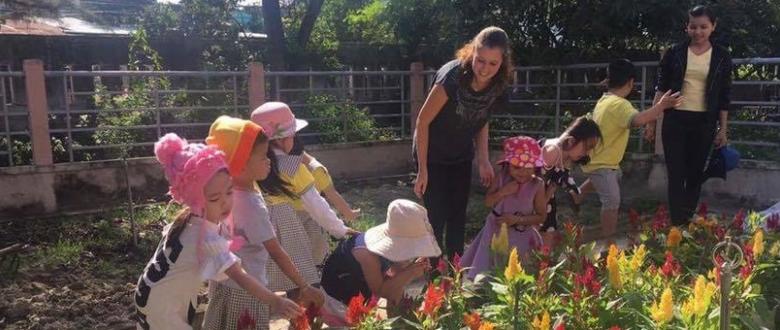
Yara Celis and Jill Seghers just graduated as kindergarten teachers from the Belgian University College Karel de Grote, one of the long-term operational partners of VVOB. This year, they had the chance to teach 4 and 5 year-old children at a kindergarten in Central Vietnam, in Tam Ky, for 3 months. Despite the language barrier, they used the Child Observation approach to include all children in their teaching.
How did the children react when they first met you?
Jill: At first, they were a bit distant, as they didn’t know whether they were allowed to talk to us. But then they started asking me questions. As I couldn’t understand Vietnamese, I replied in Dutch. They started laughing because they didn’t understand me either.
Is there a child who left a stronger impression on you?
Jill: In one of my classes, Kiet, was described to me as the bully of the class. He often looked sad, didn’t smile, teased and hurt other children, cried and yelled most of the time and usually sat in a corner by himself. After observing him for a while, I rated his level of well-being at 2. I evaluated his level of involvement at 1 because he was not interested in the activities, was doing his own thing, was wandering around…
Yara: When entering one of the classrooms for the first time, I immediately saw Tuong. This 4 year-old girl was deaf and mute, and often put aside by her teachers during the activities. I could see that she was unhappy about it, and rated her level of wellbeing at 2. As she couldn’t take part in the activities, she was bored and I estimated her level of involvement at 1.
Note: For understanding the levels of wellbeing and involvement, please refer to the Leuven Scales here.
Did you manage to get all the children involved? How?
Yara: “I observed the children a lot. Then, I based my activities on their interests and needs and they really liked it. That was the key to success!”
Both: “We introduced corner play by dividing the space into variously themed corners. We also used a lot of natural materials (like sticks, mud, water, sand, stones…) as well as recycled materials (toothbrushes, straws, plastic forks, bottles, toilet rolls,…) to create new toys and play around. We also did some excursions to the flower garden, the pond, the swimming pool,… Here are some examples of the activities that we organised (see photos):
- Using mud to paint friendship trees. Nature brought children closer, as they were painting in groups. They loved making themselves dirty! We let them take initiative on how to use the mud (paint with a stick, their hands, their arms, their feet,…) and what kind of tree to paint.
- Cooking “spaghetti Bolognese”. First, they could observe, smell, feel, taste… the ingredients. They were surprised to be allowed to cut the vegetables themselves! We then all enjoyed our meal together. For many of them, it was their first time trying a western dish.
- Creating scrub for their mothers, on international women’s day. That was another occasion to make their hands dirty and they were really excited about it! They could choose to use all kind of ingredients, like salt, oil, fruits… and mix them in a bowl. After all, you could tell how proud they were of having made it themselves!
- On that day, we organised a “Spa Day”: for a day, each child became a hairdresser, a masseuse/masseur, owner of a nail salon, a little restaurant,… Parents were very proud of their children!
After all those activities, how were the children doing?
Jill: Now, Kiet became an “example child.” I figured that he used to act like he did because he was bored by the classical activities. I got him involved in activities based on his interests and initiatives. He then started playing with other children, sharing toys without fighting… He is a completely different child!
Yara: Tuong can perfectly compete in each activity, you just have to visualise them. Each child has different interests and needs, and when responding to those, you can get them involved… And they learn so much! I am very satisfied now that I look back, because I know that Tuong will be more and more involved in the activities!




